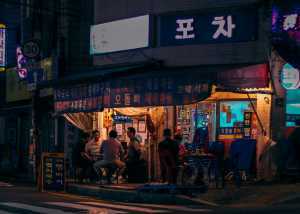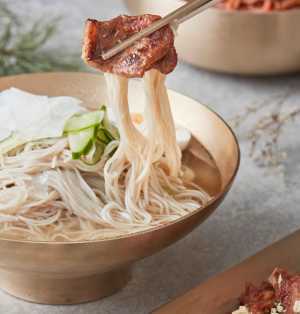It’s been nearly seven years since we moved from Seoul, and limited time and resources mean we’ve only visited three times since. There are a million things I miss about the city – the cold, bright winters, 24-hour culture, craft makgeolli, the river – but one eclipses all the rest: Pyongyang naengmyeon. I’m not someone decisive enough to have a favourite movie or album. But ask my favourite dish, and I answer without hesitation: naengmyeon. For me, it’s a quiet obsession.
At first glance, it barely makes a sound: pale buckwheat noodles, a few slivers of beef, maybe half an egg, all floating in an icy broth. No steam, no sizzle, no immediate drama. It’s the kind of thing you might overlook – until it catches you. The flavours are whisper-quiet, but the chill, the brine, the starch of the noodles – they linger. Not loudly, but persistently.
As the name suggests, the dish didn’t originate in Seoul, but in its northern counterpart, Pyongyang. However, although the austerity of North Korea is inherent to the character of naengmyeon (and possibly because I never took the opportunity to visit Pyongyang), for me this is a Seoul dish, indeed the quintessential Seoul dish, so entwined is it with my love of the city.
Mul naengmyeon
KTO
It used to be a winter dish – served in warm ondol-heated rooms, broth cold enough to make your teeth ache. These days, it’s more of a summer ritual. There’s nothing quite like a hot Seoul afternoon followed by a stainless steel bowl, fogged with condensation, broth like ice water. You lean in and catch that vinegary tang, the faint hum of mustard, the sound of your chopsticks on metal.
It’s not love at first bite, especially for the uninitiated. The broth is thin and spare. The noodles snap rather than chew. There’s little sugar, and spice is minimal. It’s restrained to the point of stubbornness. You might find yourself thinking: is that it? But that’s the point. Naengmyeon doesn’t dazzle; it makes you lean in. You sip, chew, add a little vinegar, maybe a squirt of mustard. Somewhere between that first tentative bite and the finish, you’re thinking about the next bowl.

A pojangmacha, a tented street food stall or casual outdoor restaurant commonly found in Seoul
Some of the best I’ve had came from tucked-away spots in central Seoul – places that feel like they’ve always been there. At Pildong Myeonok, near Myeongdong, the dining room feels like a page from an old novel: yellowing walls, metal bowls clinking, old fans overhead. Nearby, Eulji Myeonok sits in a neighbourhood where print shops and design studios coexist – their interiors full of concrete, ivy and wires – and out of nowhere, you’ll find a bowl of broth that feels like a time machine.
Wooraeok in Jung-gu is more stately: crisp white shirts, bulgogi smoke, and a broth with more weight. It’s not flashy, but it leaves a mark. That broth sticks in your memory long after the bowl’s empty. Across the river, Gangnam Myeonok brings minimalism: clean broth, springy noodles, no noise, no fuss. The mandu are so big you can’t eat them in one bite; you scoop up the spilt insides with a splash of ganjang and a bite of crunchy yeolmu kimchi.

Mul naengmyeon
Then there’s Eulmildae in Mapo – our favourite. Beige linoleum floors, gruff ajummas running the show, and a queue out the door before lunch. Their broth is lighter, a little beefier. The noodles have more bite. The suyuk – thin slices of slow-simmered beef, served with salt and scallion soy – is the secret weapon.
What’s lovely is that none of these places feel trendy. They’re not chasing headlines; they just are. But lately, a quiet wave of younger chefs has picked up the baton. They serve it cleaner, colder, more pared-down, but at heart it’s the same: broth, noodles, silence. Personally, I’m firmly in the cult. The minute the air turns cool, I start planning my next bowl. Sometimes it’s the smoky broth at Wooraeok. Other times it’s Eulmildae’s icy clarity with a few slices of suyuk. Or Gangnam Myeonok, with its calm, its mandu. On the best days, I’ll throw in some pyeonyuk too to make it a feast.
Bokman exterior
But I’ve learned not to push it. I’ve sat across from enough friends who just don’t get it – who think I’ve tricked them into ordering cold soup. That’s okay. Some people want fireworks. Some want warmth. Not every dish is for everyone. Still, I feel a quiet pang when someone walks away unimpressed. Not because they’re wrong, but because I wish they’d tasted what I tasted – that moment of calm, that clarity. When the broth cuts through the heat and everything else softens.
Naengmyeon, at its best, feels like a breeze through an open window. Not dramatic, but necessary. Maybe that’s why it sticks – not as nostalgia, but as something living. It connects generations. It welcomes reinterpretation. It reminds you that not every great dish needs to be loud. Some of them just need to be cold.
